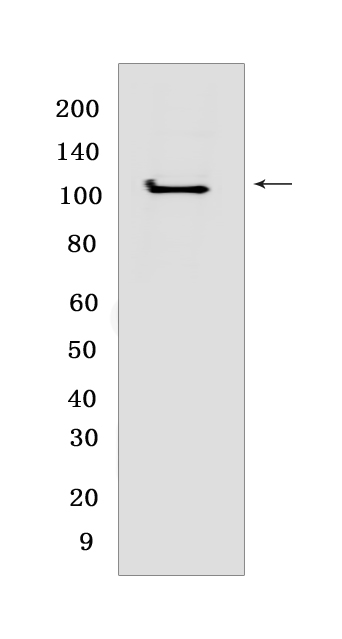RIG-I/DDX58 Rabbit mAb [43AH]Cat NO.: A86520
Western blot(SDS PAGE) analysis of extracts from A549 cells.Using RIG-I/DDX58Rabbit mAb [43AH] at dilution of 1:1000 incubated at 4℃ over night.
Product information
Protein names :DDX58,DDX58_HUMAN,Antiviral innate immune response receptor RIG-I
UniProtID :O95786
MASS(da) :106,600
MW(kDa) :107 kDa
Form :Liquid
Purification :Protein A purification
Host :Rabbit
Isotype :IgG
sensitivity :Endogenous
Reactivity :Human
- ApplicationDilution
- 免疫印迹(WB)1:1000-2000
- The optimal dilutions should be determined by the end user
Specificity :Antibody is produced by immunizing animals with a synthetic peptide at the sequence of human RIG-I/DDX58
Storage :Antibody store in 10 mM PBS, 0.5mg/ml BSA, 50% glycerol. Shipped at 4°C. Store at-20°C or -80°C. Products are valid for one natural year of receipt.Avoid repeated freeze / thaw cycles.
WB Positive detected :A549 cells
Function : Innate immune receptor that senses cytoplasmic viral nucleic acids and activates a downstream signaling cascade leading to the production of type I interferons and pro-inflammatory cytokines (PubMed:15208624, PubMed:16125763, PubMed:15708988, PubMed:16127453, PubMed:16153868, PubMed:17190814, PubMed:18636086, PubMed:19122199, PubMed:19211564, PubMed:29117565, PubMed:28469175, PubMed:31006531). Forms a ribonucleoprotein complex with viral RNAs on which it homooligomerizes to form filaments (PubMed:15208624, PubMed:15708988). The homooligomerization allows the recruitment of RNF135 an E3 ubiquitin-protein ligase that activates and amplifies the RIG-I-mediated antiviral signaling in an RNA length-dependent manner through ubiquitination-dependent and -independent mechanisms (PubMed:28469175, PubMed:31006531). Upon activation, associates with mitochondria antiviral signaling protein (MAVS/IPS1) that activates the IKK-related kinases TBK1 and IKBKE which in turn phosphorylate the interferon regulatory factors IRF3 and IRF7, activating transcription of antiviral immunological genes including the IFN-alpha and IFN-beta interferons (PubMed:28469175, PubMed:31006531). Ligands include 5'-triphosphorylated ssRNAs and dsRNAs but also short dsRNAs (<1 kb in length) (PubMed:15208624, PubMed:15708988, PubMed:19576794, PubMed:19609254, PubMed:21742966). In addition to the 5'-triphosphate moiety, blunt-end base pairing at the 5'-end of the RNA is very essential (PubMed:15208624, PubMed:15708988, PubMed:19576794, PubMed:19609254, PubMed:21742966). Overhangs at the non-triphosphorylated end of the dsRNA RNA have no major impact on its activity (PubMed:15208624, PubMed:15708988, PubMed:19576794, PubMed:19609254, PubMed:21742966). A 3'overhang at the 5'triphosphate end decreases and any 5'overhang at the 5' triphosphate end abolishes its activity (PubMed:15208624, PubMed:15708988, PubMed:19576794, PubMed:19609254, PubMed:21742966). Detects both positive and negative strand RNA viruses including members of the families Paramyxoviridae: Human respiratory syncytial virus and measles virus (MeV), Rhabdoviridae: vesicular stomatitis virus (VSV), Orthomyxoviridae: influenza A and B virus, Flaviviridae: Japanese encephalitis virus (JEV), hepatitis C virus (HCV), dengue virus (DENV) and west Nile virus (WNV) (PubMed:21616437, PubMed:21884169). It also detects rotaviruses and reoviruses (PubMed:21616437, PubMed:21884169). Detects and binds to SARS-CoV-2 RNAs which is inhibited by m6A RNA modifications (Ref.65). Also involved in antiviral signaling in response to viruses containing a dsDNA genome such as Epstein-Barr virus (EBV) (PubMed:19631370). Detects dsRNA produced from non-self dsDNA by RNA polymerase III, such as Epstein-Barr virus-encoded RNAs (EBERs). May play important roles in granulocyte production and differentiation, bacterial phagocytosis and in the regulation of cell migration..
Tissue specificity :Present in vascular smooth cells (at protein level)..
Subcellular locationi :Cytoplasm. Cell projection, ruffle membrane. Cytoplasm, cytoskeleton. Cell junction, tight junction.
IMPORTANT: For western blots, incubate membrane with diluted primary antibody in 1% w/v BSA, 1X TBST at 4°C overnight.


